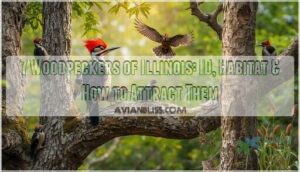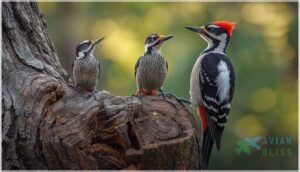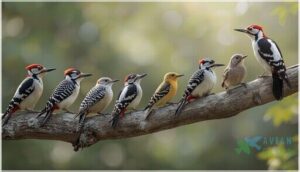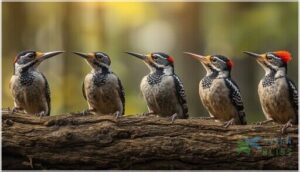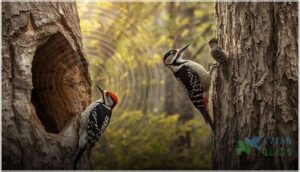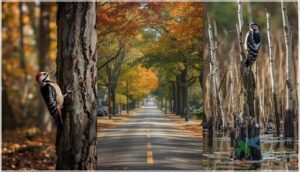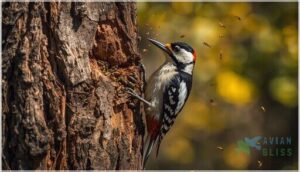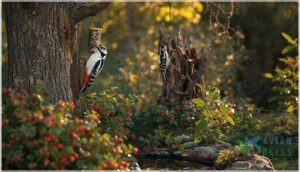This site is supported by our readers. We may earn a commission, at no cost to you, if you purchase through links.
A flash of black and white catches your eye as something hammers away at the oak tree in your backyard. You’ve just spotted one of Illinois’s seven woodpecker species—masters of survival that have been drilling, drumming, and foraging through the Prairie State’s forests for thousands of years.
From the tiny Downy Woodpecker, barely bigger than a sparrow, to the crow-sized Pileated Woodpecker with its flaming red crest, these fascinating birds have adapted to thrive in habitats ranging from dense deciduous forests to city parks.
Learning to identify each species opens up a whole new dimension of birdwatching, and with the right setup in your own yard, you can turn your property into a woodpecker haven that bolsters these essential ecosystem engineers.
Table Of Contents
- Key Takeaways
- Common Woodpecker Species in Illinois
- Identifying Illinois Woodpeckers
- Woodpecker Habitats Across Illinois
- Diet and Foraging Behaviors
- Conservation and Attracting Woodpeckers
- Frequently Asked Questions (FAQs)
- What are the most common woodpeckers in Illinois?
- Are woodpeckers good to have in your yard?
- What is the difference between a Red-headed Woodpecker and a pileated woodpecker?
- What are the 7 species of woodpeckers in Illinois?
- Do woodpeckers live in Illinois?
- What do woodpeckers eat in Illinois?
- Are northern flicker woodpeckers common in Illinois?
- Are there pileated woodpeckers in Illinois?
- Are there red headed woodpeckers in Illinois?
- Are woodpeckers active at night in Illinois?
- Conclusion
Key Takeaways
- Illinois hosts seven distinct woodpecker species ranging from the sparrow-sized Downy Woodpecker to the crow-sized Pileated Woodpecker, each adapted to specific habitats from dense forests to city parks.
- You can identify woodpeckers by examining bill length relative to head width, distinctive color patterns like the Red-headed’s fully crimson head versus the Red-bellied’s red cap, and unique calls and drumming rates that vary by species.
- Woodpeckers serve as essential ecosystem engineers by controlling wood-boring insect populations (reducing emerald ash borer larvae by up to 40%), creating nesting cavities used by over 40 other Illinois species, and promoting forest health through seed dispersal.
- You’ll attract more woodpeckers to your yard by offering suet feeders year-round, preserving dead trees for nesting sites, planting native oaks and serviceberries, and maintaining water sources—simple steps that can boost winter visits by 60%.
Common Woodpecker Species in Illinois
Illinois is home to seven distinct woodpecker species, each with its own unique characteristics and behaviors. You’ll find everything from the tiny Downy Woodpecker visiting your backyard feeders to the impressive crow-sized Pileated Woodpecker deep in mature forests.
Let’s explore each species so you can identify which woodpeckers are tapping away in your neighborhood.
Downy Woodpecker
You’ll spot the Downy Woodpecker—Illinois’s tiniest woodpecker species at just 6 to 7 inches—practically everywhere across the state. This year-round resident adapts brilliantly to both cities and countryside, making it your most likely backyard visitor. Males sport a distinctive small red patch on their head’s back.
With 4,873 reported during the 2023 Christmas Bird Count, identifying woodpeckers by sight starts here. The Pileated Woodpecker thrived during that count, with 478 individuals observed.
Hairy Woodpecker
The Hairy Woodpecker is the Downy’s larger cousin, measuring 9 to 10 inches with a longer, chisel-like bill. You’ll find this year-round resident in mature forests and suburban backyards across Illinois, preferring larger trees and snags.
Identification Tips:
- Long, pointed bill (larger than Downy’s)
- Black and white striped head pattern
- Black back with white streaks
- Stable long-term population trends
Hairy Woodpeckers share similar habitat preferences with Downy Woodpeckers but show a marked preference for substantial trees, making them less frequent backyard visitors overall. They play a key role in controlling insect populations.
Northern Flicker
Unlike most woodpeckers that hitch up tree trunks, Northern Flickers hunt on the ground, probing lawns for ants and beetles with their long, curved bills. This partial migrant species shows seasonal population shifts across Illinois. You’ll spot their distinctive flecked tail and wings, plus a black marking on the face. Their bright yellow or red-shafted feathers flash when they fly, making them unmistakable. Ground foraging sets them apart from their tree-climbing cousins.
| Feature | Details | Identification |
|---|---|---|
| Size | Medium | 11–12 inches |
| Bill | Long, curved | Specialized for ground probing |
| Plumage | Flecked tail, spotted belly | Yellow/red shafts visible in flight |
| Behavior | Ground foraging | Searches for ants, beetles |
| Migration | Partial migrant | Seasonal movements in Illinois |
Pileated Woodpecker
Now, if you’re hoping to see a truly impressive woodpecker species in Illinois, keep your eyes peeled for the Pileated Woodpecker. These giants favor large, mature forests with plenty of dead wood. Because habitat fragmentation limits their range, they’re rarely found in city parks.
Their powerful nesting habits shape forest management and impact ecosystem health across deciduous woods.
Red-bellied Woodpecker
Curiosity brings many birdwatchers to the Redbellied Woodpecker, a standout among Woodpecker Species in Illinois. You’ll recognize their bold red cap and black-and-white barred back.
Thanks to Range Expansion, they’re now common Backyard Visitors. Their Feeding Habits include suet and seeds, while lively Vocalizations and clever Nesting Behavior make them a favorite in diverse Woodpecker Habitats.
Red-headed Woodpecker
A flash of crimson—the Redheaded Woodpecker is hard to miss in Illinois. You’ll spot their bright red head and bold black-and-white wings, but don’t let their beauty fool you.
Population Decline from Habitat Loss makes Conservation Efforts essential.
Their Diet Preferences include insects and nuts, and learning their Nesting Habits helps with Woodpecker Identification and Attracting Woodpeckers to your yard.
Yellow-bellied Sapsucker
During spring and fall migration, the Yellow-bellied Sapsucker passes through Illinois as the state’s only strongly migratory woodpecker. You’ll recognize them by their bright yellow belly, reddish crown, and distinctive sap wells they drill into tree bark. Unlike other insect-hunting woodpeckers, sapsuckers sip tree sap and eat insects attracted to their wells.
Here’s what makes them unique:
- Migrate through Illinois primarily April–May and September–October
- Drill characteristic series of holes called sap wells
- Prefer orchards and planted trees over native forests
- Some individuals overwinter in Illinois towns
- Show declining population trends across the upper Midwest
Identifying Illinois Woodpeckers
Spotting a woodpecker in your backyard is exciting, but figuring out which species you’re looking at can be tricky at first. Illinois woodpeckers have distinct features that make identification easier once you know what to look for.
Let’s break down the key characteristics that’ll help you tell one species from another.
Size and Physical Features
When you’re trying to identify a woodpecker, size matters—a lot. Illinois hosts species ranging from the petite 5.5-inch Downy Woodpecker, weighing barely an ounce, to the impressive Pileated, stretching nearly 19 inches and tipping scales at 12 ounces. Bill size varies too: Downies sport short, stubby bills, while Hairy Woodpeckers wield chisel-like beaks twice as long.
Wingspan, tail function as a stabilizing prop, and zygodactyl feet structure (two toes forward, two back) all help you nail down which species you’re watching.
| Species | Length & Weight |
|---|---|
| Downy Woodpecker | 5.5–7.1 in; 0.7–1.2 oz |
| Hairy Woodpecker | 9.5 in; 1.4–3.4 oz |
| Pileated Woodpecker | 16–19.5 in; 8.8–12.3 oz |
Color Patterns and Markings
Plumage acts like nature’s fingerprint for woodpecker identification. Red head variations help you separate species fast—Red-headed Woodpeckers display fully crimson heads, while Red-bellied males sport a red cap stretching from beak to nape. Watch for these identifying characteristics:
- Black and white stripes on Downy and Hairy backs versus horizontal barring on Flickers
- Wing pattern differences like the Sapsucker’s bold white patch
- Facial stripe distinctions including the Pileated male’s red “mustache”
- Juvenile plumage appears muted; young Red-heads lack their signature crimson
Environmental color influence from Illinois’s humid climate nudges some birds toward darker feather patterns.
Bill Shape and Length
Bill size acts as a quick-reference guide for pinpointing woodpecker species. You’ll notice dramatic differences when comparing beaks—from the Downy’s delicate profile to the Pileated’s powerful excavation tool. These chisel-like bills reveal foraging adaptations and dietary influences that shape each species’ lifestyle.
| Species | Bill Length | Key Function |
|---|---|---|
| Downy Woodpecker | Under 15 mm | Fine pecking on small branches |
| Hairy Woodpecker | Up to 23 mm | Excavating harder wood substrates |
| Yellow-bellied Sapsucker | 18-22 mm | Drilling precision sap wells |
| Northern Flicker | 40-45 mm | Probing soil and wood |
| Pileated Woodpecker | 45+ mm | Creating large rectangular cavities |
Bill length relative to head width offers reliable species identification—Downy bills appear noticeably shorter than head width, while Hairy bills match it almost perfectly.
Distinctive Calls and Drumming
Beyond beaks, woodpecker vocalizations and drumming reveal identity fast. Northern Flickers belt out an 8-second rolling rattle, while Downy Woodpeckers tap a sharp “pik” every half-second. Drumming substrate choice matters—Pileateds favor hollow trunks for booming depth, Hairies hammer at 25 beats per second.
These communication function signals attract mates and defend turf, lighting up specialized forebrain regions. Listen closely: species drumming rates and call temporal patterns decipher woodpecker behavior instantly.
Woodpecker Habitats Across Illinois
Woodpeckers in Illinois aren’t picky about where they set up shop, but each species does have its favorite spots. You’ll find them drumming away in everything from deep forests to your own neighborhood trees.
Let’s look at the main types of habitats where you’re most likely to spot these birds across the state.
Deciduous and Mixed Forests
Across Illinois’s deciduous forests—which cover about 3.6 million acres—you’ll find prime woodpecker habitats filled with oaks, hickories, and maples. These wooded habitats support all seven local species, though species distribution varies.
Red-headed Woodpeckers favor open oak stands with scattered dead trees, while Pileated Woodpeckers stick to extensive bottomland forests.
Habitat management focusing on edge effects and nesting preferences has boosted forest composition diversity, helping woodpecker populations thrive statewide.
Urban and Suburban Areas
You might be surprised to find seven woodpecker species thriving right in Illinois towns and suburbs. Downy, Hairy, and Red-bellied Woodpeckers are year-round backyard regulars, drumming on gutters and visiting bird feeders. Northern Flickers forage on lawns, while urban parks with woodland patches over five acres support diverse populations.
Human impact has challenged Red-headed Woodpeckers—they’ve declined 60% since the 1960s—making conservation efforts critical for Illinois’s urban-adapted species.
Parks, Woodlots, and Backyards
Illinois urban parks recorded higher bird diversity than backyards in summer studies, with Pileated Woodpeckers visiting larger park woodlands. However, your backyard can still attract woodpeckers year-round when you maintain mature trees and dead snags.
Red-bellied Woodpeckers thrive in woodlots as small as 10 acres, while Downy and Hairy Woodpeckers readily use bird feeders with suet. Structural features like standing deadwood matter more than space alone.
Diet and Foraging Behaviors
Woodpeckers aren’t picky eaters, but they’ve developed some pretty specialized ways to find food. From hammering into bark for hidden insects to surprising ground-feeding habits, each species has its own foraging style.
Let’s look at how these birds hunt, what they eat, and how you can support them at your feeders.
Insect Hunting Techniques
Woodpeckers are nature’s insect control specialists, using fascinating techniques to find their meals. When you watch them hunt, you’ll notice impressive strategies that make them so effective:
- Drumming Behavior helps them detect insects moving inside wood—up to 20 strikes per second during active foraging.
- Bill Adaptations let them chisel through hardwood, creating rectangular holes up to 10 cm deep.
- Tongue Mechanics extend four times beyond their bill length, with sticky barbs grabbing hidden larvae.
- Prey Detection focuses on bark crevices where beetle larvae and carpenter ants hide.
- Foraging Location varies—downy woodpeckers work upper trunks while northern flickers hunt ground-dwelling ants.
Their specialized hunting eliminates up to 79% of wood-boring insect infestations.
Feeding on Fruits, Nuts, and Sap
Beyond insects, Illinois woodpeckers show considerable dietary flexibility with seasonal shifts. Red-bellied woodpeckers crack acorns and cache nuts in bark crevices for winter. Yellow-bellied sapsuckers drill sap wells in birch trees, creating sugary food sources when insects are scarce. Northern flickers supplement their diet with berries from chokecherry and hawthorn, especially when cold months limit other options. This adaptability keeps them thriving year-round.
Use of Bird Feeders
In your backyard, suet preferences drive woodpecker feeder visits year-round. Downy, hairy, and red-bellied woodpeckers readily use metal suet cages and platform feeders, with peanuts and sunflower seeds as secondary choices. Pileated woodpeckers occasionally appear at larger woodpecker feeder setups.
Winter brings peak activity when natural foods decline. This bird feeding habit strengthens local populations, reshapes community composition, and deepens your connection to these striking forest dwellers.
Conservation and Attracting Woodpeckers
Most Illinois woodpeckers are doing well, but some species face real challenges from habitat loss and declining food sources.
The good news is that you can make a difference right in your own backyard.
Let’s look at conservation concerns, ways to help these amazing birds thrive, and the important role they play in keeping our forests healthy.
Conservation Status and Threats
Most woodpecker species in Illinois face real challenges, though their conservation status varies widely. You’ll want to understand the key threats:
- Habitat loss from urbanization hits species like the Red-headed Woodpecker hardest—populations have crashed over 80% in recent decades due to regional declines
- Pesticide exposure and insecticides reduce essential insect prey
- Invasive species and predation risks further strain vulnerable populations
Habitat Preservation Efforts
You can make a real difference by supporting habitat preservation efforts across Illinois. Grant programs like the Illinois Habitat Fund and Conservation 2000 protect wooded habitats and forest ecosystems critical for woodpeckers.
School initiatives bring native vegetation to campuses, while savanna restoration projects reopen oak canopies. Snag retention guidelines help landowners leave standing dead trees, and private incentives fund conservation easements that secure nesting sites long-term.
Tips for Attracting Woodpeckers to Yards
You can draw woodpeckers right to your property with a few smart moves. Set up suet feeders and woodpecker feeders stocked with black-oil sunflower seeds—they boost visits by 60% in winter.
Plant native plants like oaks and serviceberries, add water sources year-round, and preserve dead trees for nesting spaces.
Attracting woodpeckers to your yard transforms backyard birding into a daily show.
Ecological Benefits of Woodpeckers
Beyond their beauty, these birds work as tireless pest controllers—reducing emerald ash borer larvae by up to 40% and keeping wood-boring beetles in check.
Woodpeckers control pests relentlessly, slashing emerald ash borer larvae by up to 40 percent while keeping wood-boring beetles in check
They create cavities that over 40 Illinois species depend on for nesting.
Their foraging aids tree health, boosts forest regeneration through seed dispersal, and strengthens ecosystem resilience. That’s pest control, habitat creation, and forest vitality rolled into one bird.
Frequently Asked Questions (FAQs)
What are the most common woodpeckers in Illinois?
Illinois hosts seven woodpecker species year-round or seasonally. You’ll spot downy, hairy, red-bellied, and pileated woodpeckers throughout all seasons.
Northern flickers and red-headed woodpeckers migrate, but some overwinter, while yellow-bellied sapsuckers pass through during spring and fall migrations.
Are woodpeckers good to have in your yard?
While woodpecker damage worries some homeowners, these birds excel at pest control and cavity creation.
You’ll benefit from their insect control and ecosystem health contributions, making them valuable assets for backyard biodiversity in Illinois yards.
What is the difference between a Red-headed Woodpecker and a pileated woodpecker?
You’ll notice size first—Pileated Woodpeckers tower at 16-19 inches, while Red-headed Woodpeckers measure just 8-9 inches.
Their plumage details differ dramatically: Red-headed species sport completely solid crimson heads with striking white bellies, whereas Pileated Woodpeckers display distinctive black-and-white facial stripes beneath their prominent red crests.
What are the 7 species of woodpeckers in Illinois?
You can spot seven woodpecker species in Illinois: the Downy, Hairy, Red-bellied, Red-headed, Northern Flicker, Yellow-bellied Sapsucker, and Pileated Woodpecker. Each brings unique identification challenges and habitat preferences worth exploring.
Do woodpeckers live in Illinois?
Seven woodpecker species regularly occur throughout the state, with four year-round residents and three seasonal visitors.
Illinois maintains healthy populations across diverse habitats, making birdwatching opportunities excellent for observing these fascinating birds.
What do woodpeckers eat in Illinois?
These birds are eating machines! Their diet shifts dramatically between seasons—insects like beetles and caterpillars dominate warmer months, while fruits, nuts, and suet feeders become essential winter food sources across varied Illinois habitats.
Are northern flicker woodpeckers common in Illinois?
Yes, Northern Flickers are common throughout Illinois year-round. You’ll find them in forests, parks, and backyards across all regions.
Their population remains stable, making them one of the state’s most widespread woodpeckers.
Are there pileated woodpeckers in Illinois?
Pileated Woodpeckers thrive in Illinois as permanent residents, inhabiting mature forests statewide.
Population growth reflects improved forest management and habitat preservation since the mid-20th century, though urban avoidance limits sightings to woodland areas.
Are there red headed woodpeckers in Illinois?
Ever wonder why vivid scarlet heads seem to flash through Illinois trees? Red-headed Woodpeckers thrive here year-round, though habitat loss and population decline threaten their presence.
Conservation efforts focus on protecting nesting sites and migration patterns critical for survival.
Are woodpeckers active at night in Illinois?
No, woodpeckers aren’t truly nocturnal in Illinois. They’re daytime foragers that roost in cavities at night.
Occasional crepuscular drumming near dawn or dusk happens, but nighttime sounds often come from misidentification sources instead.
Conclusion
Think of your yard as a stage where woodpeckers of Illinois perform their daily routines—drumming, foraging, and raising their young. By providing the right mix of food sources, nesting sites, and natural habitat, you’re not just observing these fascinating birds; you’re actively supporting their survival.
Each suet feeder you hang and every dead tree you leave standing strengthens the connection between your property and the broader ecosystem these noteworthy birds depend on.
- https://wildlifeillinois.org/identify-wildlife/woodpecker/
- https://www.facebook.com/groups/179784035376368/posts/10095803920440947/
- https://avianreport.com/identification-woodpeckers-northeast/
- https://www.ideals.illinois.edu/items/89349/bitstreams/229132/data.pdf
- https://www.reconnectwithnature.org/news-events/co-existing-with-wildlife/how-to-coexist-with-woodpeckers/

